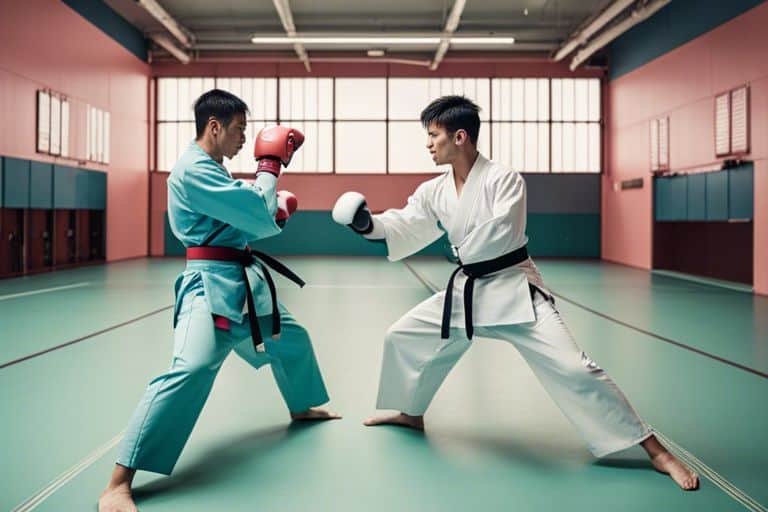If you’ve been practicing traditional karate for a while, you may be curious about Kudo and how it differs from what you’ve been doing. While both martial arts have their roots in Japan, Kudo sets itself apart with its emphasis on full-contact sparring and grappling techniques. Unlike traditional karate, Kudo allows and encourages strikes to the head and face, and utilizes a unique set of protective gear to ensure the safety of its practitioners. Both disciplines share a focus on discipline and self-improvement, but Kudo offers a more realistic approach to self-defence.
Key Takeaways:
- Focus on self-defence: Kudo places a greater emphasis on real-life self-defence techniques compared to traditional karate, which may focus more on forms and rituals.
- Full-contact sparring: Kudo incorporates full-contact sparring with protective gear, allowing practitioners to test their skills in a realistic combat situation, unlike traditional karate which often involves light or no contact sparring.
- Mix of techniques: Kudo combines elements of karate, judo, and kickboxing, allowing for a more versatile and practical approach to combat, compared to the more rigid techniques of traditional karate.
- Emphasis on practicality: Kudo seeks to teach practitioners how to deal with a variety of real-life situations, including grappling and ground fighting, in contrast to the more traditional and stylised approach of karate.
- Mindset and philosophy: While traditional karate often incorporates a strong emphasis on discipline and philosophy, Kudo maintains a more practical and direct approach to training and combat, focusing on preparing practitioners for real-world scenarios.

Historical Background
When exploring the differences between Kudo and traditional Karate, it is essential to delve into the historical background of both martial arts. Kudo, also known as Daido Juku, is a modern martial art that blends the striking techniques of Karate with the throwing and grappling techniques of Judo. You can learn more about Kudo – the martial art which combines Judo and Karate here.
Origins of Kudo
Kudo was founded in 1981 by Takashi Azuma, a former Kyokushin Karate practitioner. The style was developed as a response to the limitations of traditional Karate in full-contact competitions. Kudo was created to provide a more realistic and practical approach to combat, incorporating elements of both striking and grappling to prepare practitioners for a variety of real-world situations.
Development of Traditional Karate
Traditional Karate has a rich history that dates back hundreds of years, originating on the island of Okinawa in Japan. It was developed as a means of unarmed self-defence, with a strong emphasis on discipline, respect, and personal development. Traditional Karate has evolved over time, with different styles and schools emphasising various aspects such as form, sparring, and self-defence techniques.
Philosophical and Technical Differences
When comparing Kudo and traditional karate, it is important to understand the philosophical and technical distinctions that set these martial arts apart. These differences go beyond the surface level techniques and delve into the underlying principles and mindset that guide the practice of each art.
Philosophical Principles Behind Kudo and Karate
Both Kudo and karate are rooted in rich philosophical traditions, but they have distinct emphasis. Karate, originating from Okinawa and later Japan, places a significant emphasis on discipline, self-control, and the development of character. On the other hand, Kudo, developed in the 1980s in Japan, incorporates a more dynamic and practical approach to combat, focused on real-life situations and full-contact sparring. While both arts promote discipline and self-improvement, Kudo places a stronger emphasis on practicality and adaptability in real combat scenarios.
Technical Distinctions in Techniques and Training
One of the key technical distinctions between Kudo and traditional karate lies in their approach to fighting techniques and training methods. While traditional karate places a strong emphasis on striking, blocking, and kata (choreographed patterns of movements), Kudo encompasses a wider range of techniques including striking, throwing, grappling, and ground fighting. Kudo also incorporates full-contact sparring, allowing practitioners to test their skills in realistic combat scenarios. This practical approach to training sets Kudo apart from traditional karate, as it prepares you for a wider range of combat situations and fosters a greater sense of adaptability and versatility.
Kudo and Karate in Practice
When it comes to practising Kudo and traditional karate, there are several key differences that set them apart. Kudo emphasises a more realistic and practical approach to combat, focusing on full-contact sparring and incorporating a wide range of techniques from various martial arts. In contrast, traditional karate typically places greater emphasis on forms, patterns, and prearranged techniques. To delve deeper into the specifics of Kudo and its practice, you can refer to this detailed guide on Kudo Martial Art – A Complete Guide – Master Fighting.
Competitive Framework and Rules
In Kudo, the competitive framework revolves around full-contact sparring with opponents wearing protective gear, including headgear, gloves, and body armour. The matches take place in a ring, with fighters aiming to score points through effective strikes, throws, and submissions. Unlike traditional karate, Kudo allows a wider range of techniques, including punches, kicks, and grappling, creating a more dynamic and realistic combat environment. The emphasis on full-contact sparring in Kudo provides a practical approach to self-defence training, allowing you to test your skills in a controlled yet challenging setting.
Belt Ranking Systems and Progression
Kudo adopts a belt ranking system similar to other martial arts, where practitioners progress through different levels of expertise. Advancing through the ranks in Kudo involves not only mastering technical skills but also demonstrating mental fortitude, discipline, and adaptability. As you progress in Kudo, you will develop a deeper understanding of combat strategies and gain the confidence to handle real-life self-defence situations. Additionally, the emphasis on practical application and full-contact sparring in Kudo ensures that your skills are constantly tested and honed, leading to a more well-rounded and effective martial artist.
Adaptation and Evolution in the Modern Era
In the modern era, martial arts have undergone significant changes and developments, driven by advancements in training methods and a greater understanding of human physiology. Both Kudo and traditional karate have had to adapt to these changes in order to remain relevant and effective in today’s martial arts landscape.
Kudo’s Response to Contemporary Martial Arts Trends
Kudo has responded to contemporary martial arts trends by integrating elements of other combat sports, such as boxing and wrestling, into its training and competition format. This evolution has made Kudo a well-rounded and effective martial art, incorporating techniques from various disciplines to prepare you for a range of real-world self-defence scenarios.
Traditional Karate’s Place in Today’s Martial Arts World
Traditional karate continues to hold its place in the martial arts world, offering a strong emphasis on discipline, respect, and character development. However, in the context of modern self-defence needs, some practitioners argue that traditional karate may not always provide the practical training required for real-life situations.
While traditional karate’s focus on form and technique is valuable, it may benefit from adapting to include more realistic, full-contact training to better prepare you for today’s self-defence challenges.
FAQ
Q: How does Kudo differ from traditional Karate?
A: Kudo differs from traditional Karate in a few key ways. Kudo incorporates both striking and grappling techniques, whereas traditional Karate is primarily focused on striking. Additionally, Kudo places a strong emphasis on full-contact sparring, while traditional Karate often involves point sparring or kata practice. Kudo also allows for a wider range of techniques and strategies compared to the more rigid structure of traditional Karate.
Q: What are the main principles of Kudo?
A: The main principles of Kudo include practicality, effectiveness, and adaptability. Kudo aims to provide practitioners with a well-rounded set of skills that can be used in real-life self-defence situations. It also emphasises the importance of conditioning and mental fortitude.
Q: Is Kudo more physically demanding than traditional Karate?
A: Yes, Kudo is generally more physically demanding than traditional Karate. The inclusion of grappling techniques and full-contact sparring requires a higher level of physical conditioning and endurance. Kudo practitioners also engage in rigorous training to prepare for the demands of the discipline.
Q: Can someone with no martial arts experience start learning Kudo?
A: Yes, individuals with no martial arts experience can start learning Kudo. However, it is important to find a qualified instructor who can provide proper guidance and instruction from the beginning. Beginners should be prepared for the physical and mental challenges that come with learning Kudo.
Q: Are there different forms or styles of Kudo?
A: Kudo is primarily taught as a single, unified style with a focus on practical self-defence. While there may be minor variations in techniques or training methods between different instructors, there are no distinct “styles” of Kudo in the same way that traditional Karate has different branches and schools.
Q: What are the benefits of practicing Kudo over traditional Karate?
A: The benefits of practicing Kudo over traditional Karate include a more comprehensive approach to self-defence, a more intense physical workout, and a greater focus on practical application of techniques. Kudo also provides an opportunity for practitioners to develop a broader skill set that can be adapted to various combat scenarios.
Q: Can Kudo be used for self-defence in real-life situations?
A: Yes, Kudo is designed to be effective for self-defence in real-life situations. The combination of striking and grappling techniques, along with full-contact sparring practice, prepares practitioners to defend themselves in a practical and realistic manner. However, as with any martial art, proficiency and proficiency depend on consistent training and skill development.



